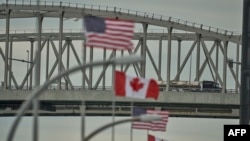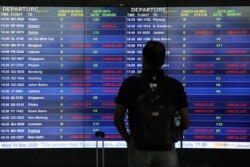Wednesday brought new restrictions on movement in North America and Malaysia, as well as the start of a European Union ban on entry to foreigners, as governments seek to control the spread of the novel coronavirus.
While the U.S. announced it will temporarily close its northern border with Canada to “non-essential traffic,” travelers created logjams at European border crossings, as infections worldwide approached 200,000, and the death toll exceeded 7,500.
European countries have also shut their borders to non-essential traffic, but many crossings remain open to cross-border employees and trucks transporting medicine and other critical goods.
As confirmed cases climbed to 790 in Malaysia, the hardest-hit country in Southeast Asia, the country announced a partial lockdown for two weeks, triggering massive traffic jams on the causeway between Malaysia and Singapore.
Elsewhere in Asia, China, where the outbreak began, reported few new cases on Wednesday.
In Saudi Arabia, officials on Wednesday told private sector businesses to have all their employees telework if possible, and for those who have to physically be present to take steps to keep their distance from each other.
Australian Prime Minister Scott Morrison declared a “human biosecurity emergency” Wednesday, clearing the way for the government to impose curfews and quarantines.
Other countries have already taken those steps to halt public life.
Italy, Spain and France are currently under severe bans on movement as they deal with some of the highest number of cases in the world.
Germany, with nearly 9,900 confirmed cases, is bracing for a sharp spike in infections, after a top government health official warned Wednesday that as many as 10 million people could be infected.
But Germany’s Robert Koch Institute head Lothar Weiler said the number of infections could be significantly reduced if social interactions were curtailed.
Weiler also warned that the outbreak could continue to impact Germany for up to two years.
In Brazil, where there are more than 300 cases, the agency that oversees public parks announced closures in accordance with health officials’ guidance for people to avoid crowds. The ban includes the famous Christ The Redeemer statue that overlooks Rio de Janeiro.
Brazil reported its first coronavirus death on Tuesday.
The virus has reached 159 countries, with more than 185,000 confirmed cases and 7,500 deaths, according to the World Health Organization.
Kyrgyzstan was the latest to report its first case Wednesday. It has already closed its borders to foreigners.
China was the first to report a case of the COVID-19 virus and has been the hardest hit with more than 82,000 cases. But the situation there has been steadily improving in recent weeks, and the city of Wuhan, the center of the outbreak, reported a single new case on Wednesday.
The virus has been blamed for 100 deaths in the United States where officials are urging people to avoid being in groups larger than 10.
About 7 million people in the San Francisco area have been told to shelter in place. New York City Mayor Bill de Blasio said he will decide by Thursday whether to institute a similar order for the country’s most populous city.
Late Tuesday, the governors of two states – California and Kansas – announced that public schools may have to stay closed until the fall.



